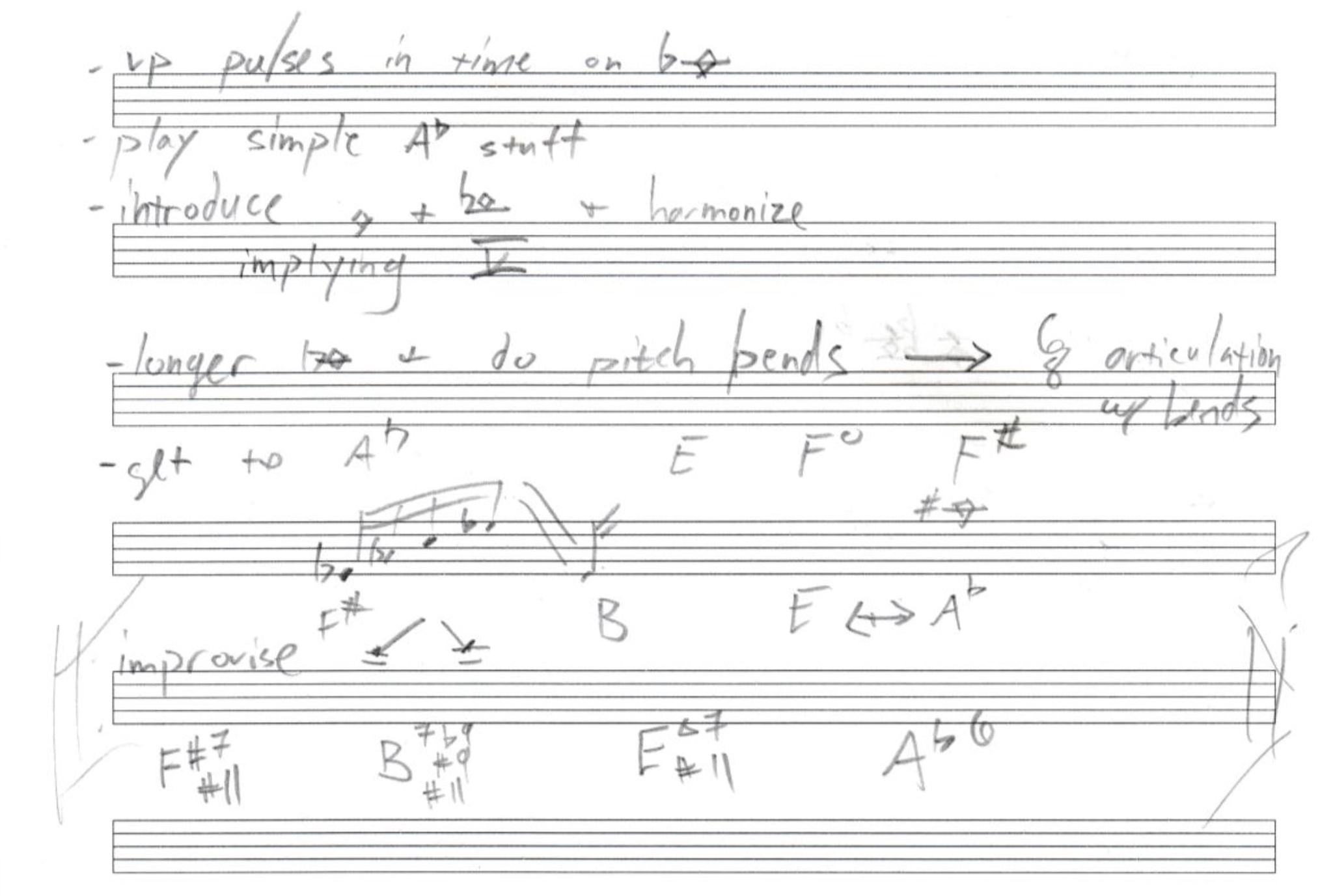Analysis
I began the AGNI cycle anew to write a second piece that expanded and improved my feedback saxophone system thus far. Stride was limited in and by its equipment, musical language, and notation. Placing the Beta 57 microphone in the saxophone occasionally scratched the inside of the bell and prevented the bottom three conventional notes from sounding correctly, a limitation that contributed to the work not using conventional sound. While developing the piece, there were several instances of piercing feedback, both when I was working alone and when I was presenting my research – an unsustainable and dangerous hazard. Whereas Stride had only employed feedback gestures on their own, I was curious if and how feedback tones could be combined with conventional playing. The notation in Stride was also limited by its two-staff system, which was useful for documenting initial findings, but cumbersome for denser music.
Grammar
To address the limiting factors of the Beta 57, I began using a small “lapel” microphone, the DPA 4060,1 which facilitated the feedback notes I had discovered, was lighter and never scratched the saxophone, and did not encumber the regular playing of the instrument. To avoid feedback experiences that could be harmful to the ears, I added a Boss CS-3 compression pedal2 that amplified soft sounds while limiting loud ones. Not only did the compression pedal make this research safer for my audiences and I, but its tone knob enabled a wider variety of feedback notes. Similarly, I added a Boss FV-500L volume pedal3 that allowed me to quickly mute and dynamically shape the feedback tones, as seen and heard in the scores and recordings. Adding a Boss GE-7 equalization pedal4 enabled the tuning of specific feedback pitches. I also discovered that the much smaller Roland COSM Cube 305 amplifier worked with this updated instrumentarium while also providing a broader spectrum of timbres. Figure 5-6 depicts this new instrumentarium and its signal flow.
I chose to maintain the relatively transparent musical aesthetic of the first piece, as I was adding a completely new technique: combining conventional playing with feedback to create harmony. The nature of the low Larsen tones used in Stride meant that it was difficult to combine acoustic playing with them. The feedback tones I consequently used for this second piece were an octave and a half above the pitches in Stride and, rather than appear as standalone melodic shapes moving through a scale, they were clustered close together to act as drones around which conventional notes could travel. Figure 5-7 shows some melodies surrounding a single feedback note, in addition to figures involving conventional and feedback pitches moving together. In Klezmer and Balkan music, the doina is a free-form, highly ornamented improvised tune. Having played much of these musics as a professional, I felt Doina to be an appropriate name for this second etude considering the musical grammar I had devised.
Figure 5‑7: Grammar sketch for Doina.6
Notation
The new feedback notes in Doina no longer could be thought of or notated as being related to a fundamental pitch or fingering. I therefore devised a single-staff system in which feedback tones were represented by diamond noteheads, making the notation more in line with conventional contemporary saxophone scoring and easier to read. Figure 5-8 shows a sketch I had made for the form of Doina that I used like a “chord changes” jazz chart to improvise over. I recorded myself playing this form many times while noting how I could continue to shape the piece before recording it.
Implementation
Rather than develop a score from repeated improvisations, like I had with Stride, I instead transcribed a performance I had done of Doina for a lecture-recital. Such an approach is used in jazz pedagogy and while the improvised solos of the jazz tradition are not intended to be notated in such a way, it is nevertheless a common exercise. The score can be accessed in Appendix 2 and the video recording is below.
For the finished score, I added a thick horizontal line above the staff to indicate an ongoing feedback tone (fig. 5-9). Accompanying this line are also dynamic markings, which are controlled by the volume pedal. At a glance, a saxophonist may assume the diamond noteheads are harmonics or multiphonics, but the line above the staff should alert any interpreter that something different is required and that they should look to the front matter for instructions. I placed the rehearsal markings relative to where the music changed character or harmony, rather than follow the original form sketch.


